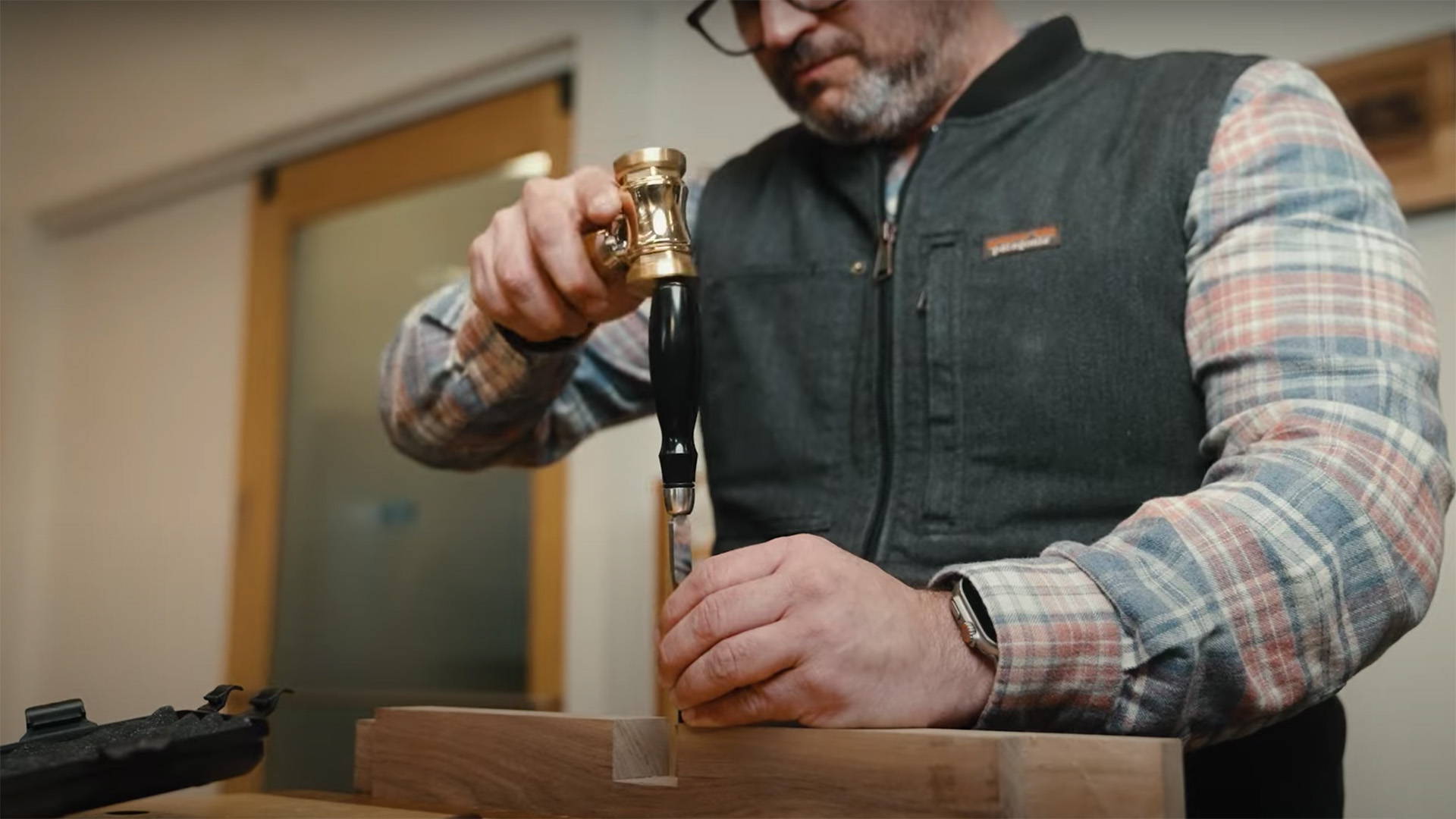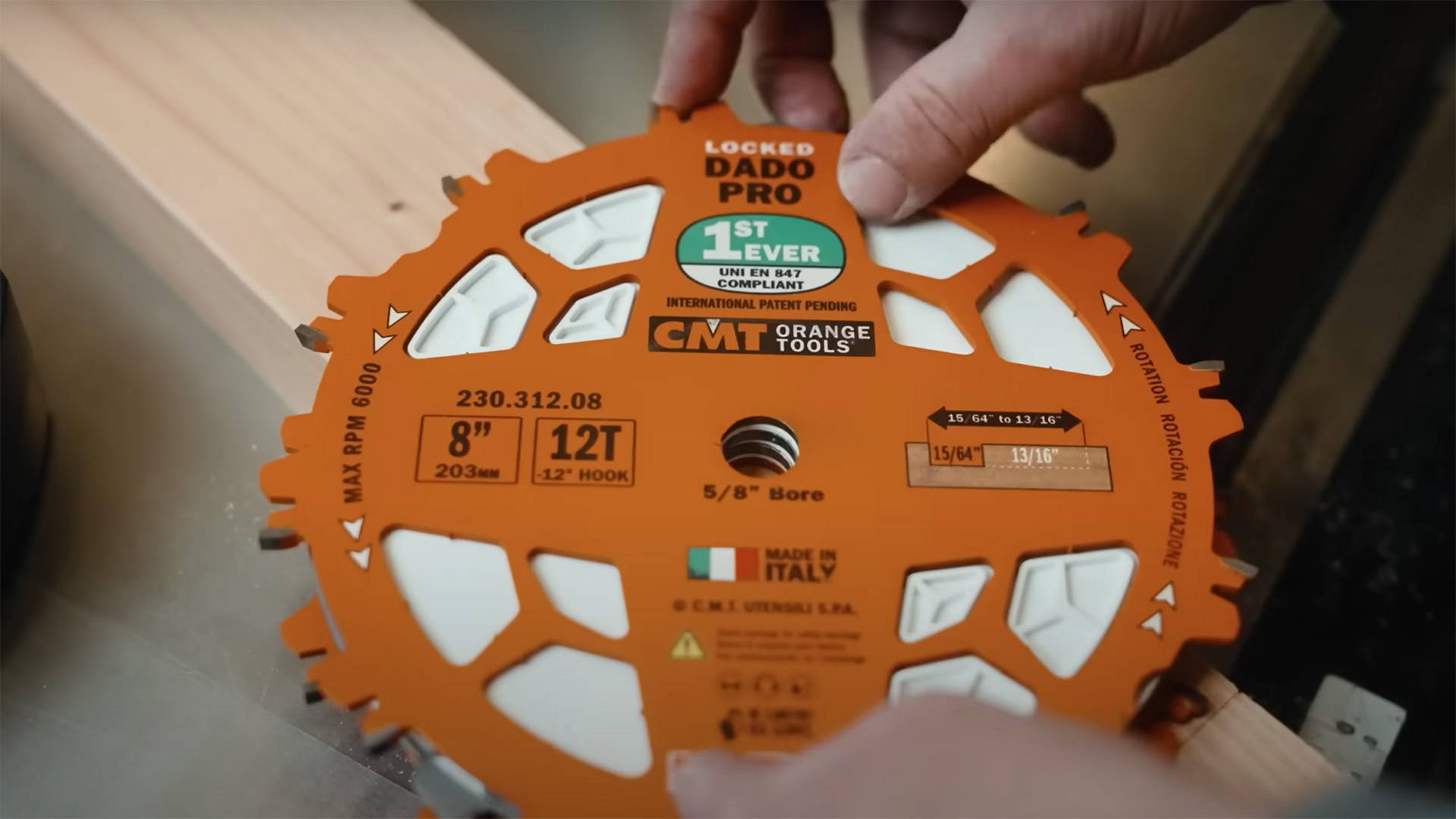No woodshop is complete without a roll of blue painter's tape.
This understated consumable has a ton of uses — from preventing tearout to controlling glue squeeze-out.
And best of all, it's ridiculously affordable.
Today, I'm giving you 5 ingenious ways to use blue tape for woodworking...
So you can have a safer and easier time with your projects — and avoid some sticky situations.
A NOTE ABOUT BLUE TAPE AND SUPER GLUE
A lot of people like to use blue tape and super glue in place of double-sided tape for attaching templates to boards. But I find it inefficient.
You need to use twice as much tape (a piece for each side). It’s also more difficult to line up the two pieces accurately — and glue can get on your workpiece where you don’t want it.
Good double-stick tape has a ton of hold, leaves no mess, and makes the process a lot faster.
That said, blue tape is SUPER useful for other applications — as you’ll see in the tips below.
1. PREVENTING TEAROUT
Blue tape is fantastic for preventing tearout and getting cleaner cuts.
Slap a strip down on the area where the blade teeth will exit the cut. The tape acts as a barrier, holding down the wood fibers and preventing them from tearing out.
It's especially useful for jigsaws and circular saws (notorious for tearout), but also works great on your bandsaw, table saw, and miter saw.
2. CONTROLLING GLUE SQUEEZE-OUT
Ever glued up a project and glue squeeze-out goes everywhere it shouldn’t? Not fun.
Before grabbing the glue, outline all the shoulders of your joinery with blue tape. It blocks excess glue from dripping everywhere, and makes cleaning up a cinch.
Just make sure you don’t place the tape on the insides of the joinery where it can get stuck. A good strategy is to add the tape during a dry assembly.
3. CLAMPING MITERED CORNERS
Regular clamps don’t work well for holding mitered corners together. But blue painter’s tape works like a dream.
Lay strips of tape across the outside of the joint, add glue inside the miter, then fold the joint together. The tape has just enough stretch to act as a clamp and create a strong glue bond.
4. QUICK ZERO-CLEARANCE INSERT
If you’re cutting thin strips of wood on a table saw, the offcuts can fall through the gap in the insert plate.
To keep this from happening, place a strip of blue tape on the offcut side of the blade and seal the gap. Now your strips will stay on the table top where you want them.
You could also place a piece of tape over the entire space with the blade fully backed down. Make a slice along the back for the riving knife, turn on the saw, and slowly raise the blade.
5. MOUNTING GUIDE
When you’re mounting a power strip or picture frame on the wall, it can be hard to figure out where the mounting screws need to go. This hack makes it easy.
Lay a strip of blue tape across the back of whatever you’re mounting so it covers the mounting holes. Make sure one edge of the tape is flush with one side of the object.
Now either poke a hole or make a mark on the tape where the mounting holes are. Remove the tape, set it on the wall where you want it (you can use a level), and drill pilot holes at the marks.
Still struggling with squeeze-out? Here’s 3 other ways to control excess glue.
We now carry multiple sizes of 3M blue painter’s tape in the Katz-Moses Tools store. Stock up on your next visit!
Got any other blue tape tricks? Tell us in the comments below!
Follow us on Instagram @katzmosestools, on TikTok @katzmoseswoodworking, and check out my YouTube channel for more great woodworking content...
And as always, STAY SAFE IN THE SHOP!











12 comments
Fred Suplee
If I’m hanging more than one picture at a time, I put the tape on one side of a level and then mark the spacing on the tape. This way, I can mark the location of the hangers and make sure they’re level at the same time.
I also use it to seal tubes of caulking in between use. Simple, effective, and sometimes the tape can be used more than once.
If I’m hanging more than one picture at a time, I put the tape on one side of a level and then mark the spacing on the tape. This way, I can mark the location of the hangers and make sure they’re level at the same time.
I also use it to seal tubes of caulking in between use. Simple, effective, and sometimes the tape can be used more than once.
Anonymous
Your tip on using the tape as a mounting guide could not have arrived at a better time! I was just getting reading to mount a surge control device on my shop wall and was not looking forward to the usual hassle of squaring it up. Many thanks!
Your tip on using the tape as a mounting guide could not have arrived at a better time! I was just getting reading to mount a surge control device on my shop wall and was not looking forward to the usual hassle of squaring it up. Many thanks!
Sterve Marano
Absolutely superb tapes on using blue tape, especially the one about using it as a mounting guide!
Absolutely superb tapes on using blue tape, especially the one about using it as a mounting guide!
Basil pierre
Great tips the quick zero clearance trick is one I will use. What’s the difference between using the blue tape as opposed to using the green one?
Great tips the quick zero clearance trick is one I will use. What’s the difference between using the blue tape as opposed to using the green one?
Patrick Daniels
I’ve always had multiple tape dispensers in my shop, using tape for a one handed man is essentially how I’ve survived all my projects!
Again, thanks for all you do Johnathan!!
I’ve always had multiple tape dispensers in my shop, using tape for a one handed man is essentially how I’ve survived all my projects!
Again, thanks for all you do Johnathan!!
Jack
Blue tape is great but if it remains in place for over a week it might be difficult to remove. I am retired and take my time building build Winsor chairs period reproductions and parts are frequently labeled for several weeks before final assembly. In these situations I find green or yellow easier to remove but I always keep the blue handy.
Blue tape is great but if it remains in place for over a week it might be difficult to remove. I am retired and take my time building build Winsor chairs period reproductions and parts are frequently labeled for several weeks before final assembly. In these situations I find green or yellow easier to remove but I always keep the blue handy.
Brad
What double sided tape do you use? I either have gotten really strong tape that won’t come off or tape that is weak and doesn’t hold well enough.
What double sided tape do you use? I either have gotten really strong tape that won’t come off or tape that is weak and doesn’t hold well enough.
Karl
Not a frequent use, but I’ve used it to take a small cut off away from the table saw blade as soon as the cut is completed. Attaching the tape to the small piece and holding the other end of the tape with my free hand, I can prevent any bad things happening to the small piece I’m working on and keep my fingers a safe distance from the blade.
Not a frequent use, but I’ve used it to take a small cut off away from the table saw blade as soon as the cut is completed. Attaching the tape to the small piece and holding the other end of the tape with my free hand, I can prevent any bad things happening to the small piece I’m working on and keep my fingers a safe distance from the blade.
Jonathan Katz-Moses
@Patrick Using painter’s tape for PAINTING?! Unheard of.
@Bob Benzuly Great way to save yourself from having to sand off pencil marks!
@David Zamet Hope you get to put it to good use!
@Patrick Using painter’s tape for PAINTING?! Unheard of.
@Bob Benzuly Great way to save yourself from having to sand off pencil marks!
@David Zamet Hope you get to put it to good use!
Patrick
As Bob mentioned I use it often to identify boards, both name and orientation. I have also used it as a very thin spacer when I needed to shave “just a little” off a board. And here is an amazing thing it can be used for: taping off areas you don’t want paint on :)
As Bob mentioned I use it often to identify boards, both name and orientation. I have also used it as a very thin spacer when I needed to shave “just a little” off a board. And here is an amazing thing it can be used for: taping off areas you don’t want paint on :)
Bob Benzuly
Blue tape is my #1 go-to for labeling components. I put the name of the component, left/right, up/down, in/out, etc. on the tape. If I need to work on the surface with the tape, it’s easy to temporarily take off and then reapply.
Blue tape is my #1 go-to for labeling components. I put the name of the component, left/right, up/down, in/out, etc. on the tape. If I need to work on the surface with the tape, it’s easy to temporarily take off and then reapply.
david zamet
Hi,
Your tip number 5 “mounting guide”, is brilliant!
Many thanks and all the best,
David
Hi,
Your tip number 5 “mounting guide”, is brilliant!
Many thanks and all the best,
David